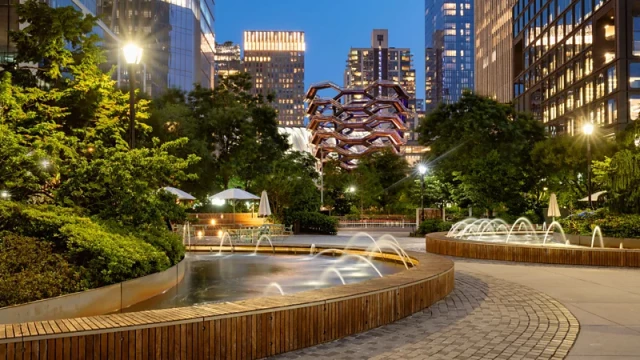In the era of hybrid work, as businesses reduce their workforce, vacant office spaces could be transformed into luxury apartments with limited natural light or present an opportunity to revitalize the city center.
With more employees working remotely in the hybrid work era, many companies are realizing the need for smaller office spaces. Instead of the pre-pandemic open floor plans designed to accommodate many employees, businesses are now focusing on more compact yet high-quality work environments for the future.
Statistics from JLL, a global commercial real estate firm, indicate that 48% of clients in major markets such as the UK, Germany, and France are planning to downsize their office spaces over the next three to five years. Stephanie Hyde, CEO UK and CEO EMEA Markets at JLL, stated, "Our clients are strategizing how to utilize their existing space by analyzing recent data and devising long-term plans." Additionally, with many leases expiring and companies prioritizing sustainability and hybrid work arrangements, the trend of downsizing is gaining momentum.
This impending corporate downsizing is expected to have significant implications for the real estate industry. As more leases expire, experts predict a surplus of commercial space in the market. According to Leesman, a workplace research firm, their data from March 2024 suggests that total space reductions could reach 40% across their global client base of 766 firms. If this trend extends to central London, it could potentially result in a reduction equivalent to 56.6 million sq ft (5.26 million sq m) of office space.
Amid the pursuit of improved work environments, the abandoned offices may remain unoccupied. Tim Oldman, founder and CEO of Leesman in London, mentioned, "More organizations are seeking spaces that enhance the workday for employees, preferably in more appealing locations within the city." As companies invest in high-quality office spaces, there is a growing void left behind for lower-grade buildings.
Not all unoccupied structures can be modernized to meet the changing demands of the market or converted into residential units. Oldman explains, "Many large organizations are striving for net zero targets, so they will relocate to newer buildings with environmental certification and the latest technology.
The substantial investment in commercial real estate, tailored for large open-plan areas, makes it impractical and uneconomical to repurpose them into homes. These buildings would only be suitable for affluent individuals and would lack natural light."
Duncan Swinhoe, managing principal for Europe at design and architecture firm Gensler in London, also notes that businesses are becoming more discerning about where they establish their headquarters. He states that a traditional tenant in the central Mayfair district, such as a hedge fund, may now prefer to move to more trendy neighborhoods that appeal to a larger number of employees. "Proximity to amenities, coffee shops, bars, and good transportation links now plays a much more significant role in location decisions – employers want to entice their staff to the office."
Despite the possibility of a market reset, Oldman believes that the commercial real estate industry and entire business districts will not be completely eradicated in the long run. He asserts, "As more companies opt for newer, visually appealing offices in prime locations with excellent interior space, the value of older buildings will decline. However, there are too many individuals with substantial investments to allow a catastrophic event to occur, leading to entire cities becoming deserted."
Oldman is of the opinion that these innovative advancements could serve as a model for revitalizing areas that have been affected by vacant office spaces.
He explains that in the past, "mixed use" referred to areas dominated by offices, some residential areas, and a few retail establishments.
However, now there is potential for these urban areas to transform into hubs of creativity, housing community-focused businesses, specialized services, and immersive spaces within a more collaborative setting.
The outcome is that urban cores are poised for a transformation. According to Swinhoe, "Twenty years ago, the focal point of urban planning was the central business district, with the financial district at its nucleus, and everything else revolving around it. Now, there is a shift towards placing the city's focus on lifestyle, entertainment, and amenities, rather than solely on business – cities are reconnecting as places where people gather to build lives, not just work."
However, the transition is expected to be prolonged as leases expire and large corporations move into smaller headquarters. The planning, development, and construction of new spaces takes time: Coal Drops Yard's development began in 2000 and it took 18 years to open; Hudson Yards was formally announced in 2004 and opened in 2019 after years of speculation.
In the near term, cities may encounter a departure of office spaces. Some cities are more vulnerable than others, largely due to lease lengths. For example, while the average lease length in London is 12 years, some major business hubs like Zürich have only five-year leases. Some city centers are already witnessing this trend: since the pandemic, lease lengths in Manhattan have dropped below 10 years, and iconic buildings such as the Flatiron remain vacant as companies downsize.
However, a deadline is approaching and there is a looming influx of commercial real estate. "In most major cities, there will be an oversupply of average and subpar spaces," says Oldman. "Developers may be compelled to be innovative, but they have approximately five years to prepare, mobilize, and get ready for the impending future."




















